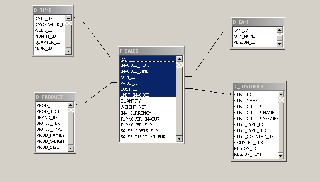| DW architecture | Snowflake schema | Constellation schema |
Star schema architecture
Star schema architecture is the simplest data warehouse design.
The main feature of a star schema is a table at the center, called the fact table and the dimension tables which allow browsing of specific categories, summarizing, drill-downs and specifying criteria.
Typically, most of the fact tables in a star schema are in database third normal form, while dimensional tables are de-normalized (second normal form).
Despite the fact that the star schema is the simpliest datawarehouse architecture, it is most commonly used in the datawarehouse implementations across the world today (about 90-95% cases).
Fact table
The fact table is not a typical relational database table as it is de-normalized on purpose - to enhance query response times.
The fact table typically contains records that are ready to explore, usually with ad hoc queries. Records in the fact table are often referred to as events, due to the time-variant nature of a data warehouse environment.
The primary key for the fact table is a composite of all the columns except numeric values / scores (like QUANTITY, TURNOVER, exact invoice date and time).
Typical fact tables in a global enterprise data warehouse are (usually there may be additional company or business specific fact tables):
Dimension table
Nearly all of the information in a typical fact table is also present in one or more dimension tables.
The main purpose of maintaining Dimension Tables is to allow browsing the categories quickly and easily.
The primary keys of each of the dimension tables are linked together
to form the composite primary key of the fact table.
In a star schema design, there is only one de-normalized table for a given dimension.
Typical dimension tables in a data warehouse are:
Star schema example
An example of a star schema architecture is depicted below.
